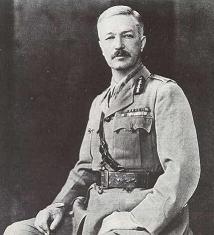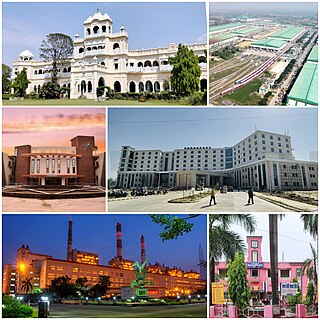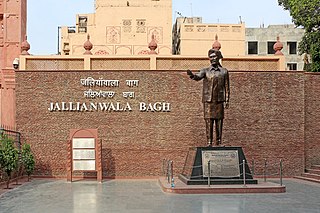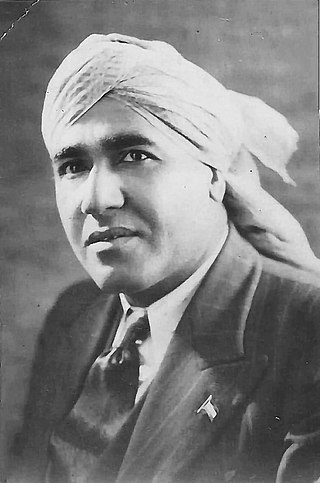
Colonel Reginald Edward Harry Dyer, was an officer of the Bengal Army and later the newly constituted British Indian Army. His military career began in the regular British Army but he soon transferred to the Presidency armies of India. As a temporary brigadier-general, he was responsible for the Jallianwala Bagh massacre that took place on 13 April 1919 in Amritsar. He has been called "the Butcher of Amritsar", because of his order to fire on a large gathering of people. The official report stated that this resulted in the killing of at least 379 people and the injuring of over a thousand more. Some submissions to the official inquiry suggested a higher number of deaths.

Amritsar, historically also known as Rāmdāspur and colloquially as Ambarsar, is the second-largest city in the Indian state of Punjab, after Ludhiana. It is a major cultural, transportation and economic centre, located in the Majha region of Punjab. The city is the administrative headquarters of the Amritsar district. It is situated 217 km (135 mi) north-west of Chandigarh, and 455 km (283 mi) north-west of New Delhi. It is 28 km (17.4 mi) from the India-Pakistan border, and 47 km (29 mi) north-east of Lahore, Pakistan.

The non-cooperation movement was a political campaign launched on 4 September 1920, by Mahatma Gandhi to have Indians revoke their cooperation from the British government, with the aim of persuading them to grant self-governance.

Raebareli is a city in Indian state of Uttar Pradesh. It is the administrative headquarters of Raebareli district and a part of Lucknow Division. The city is situated on the banks of the Sai river, 82 km (51 mi) southeast of Lucknow. It possesses many architectural features and sites, chief of which is a strong and spacious fort. As of 2011, Raebareli has a population of 191,316 people, in 35,197 households.

Jallianwala Bagh is a historic garden and memorial of national importance close to the Golden Temple complex in Amritsar, Punjab, India, preserved in the memory of those wounded and killed in the Jallianwala Bagh Massacre that took place on the site on the festival of Baisakhi Day, 13 April 1919. The 7-acre (28,000 m2) site houses a museum, gallery and several memorial structures. It is managed by the Jallianwala Bagh National Memorial Trust, and was renovated between 2019 and 2021.

Udham Singh was an Indian revolutionary belonging to Ghadar Party and HSRA, best known for assassinating Michael O'Dwyer, the former lieutenant governor of the Punjab in India, on 13 March 1940. The assassination was done in revenge for the Jallianwala Bagh massacre in Amritsar in 1919, for which O'Dwyer was responsible and of which Singh himself was a survivor. Singh was subsequently tried and convicted of murder and hanged in July 1940. While in custody, he used the name 'Ram Mohammad Singh Azad', which represents the three major religions in India and his anti-colonial sentiment.

Saifuddin Kitchlew was an Indian independence activist, barrister, politician and later a leader of the peace movement. A member of Indian National Congress, he first became Punjab Provincial Congress Committee head and later the General Secretary of the All India Congress Committee in 1924. He is most remembered for the protests in Punjab after the implementation of Rowlatt Act in March 1919, after which on 10 April, he and another leader Satyapal, were secretly sent to Dharamsala. A public protest rally against their arrest and that of Gandhi, on 13 April 1919 at Jallianwala Bagh, Amritsar, led to the infamous Jallianwala Bagh massacre. He was also a founding member of Jamia Millia Islamia. He was awarded the Stalin Peace Prize in 1952.

Sir Michael Francis O'Dwyer was an Irish colonial officer in the Indian Civil Service (ICS) and later the Lieutenant Governor of Punjab, British India, between 1913 and 1919.

The Qissa Khwani massacre in Peshawar, North-West Frontier Province, British India on 23 April 1930 was a armoured vehicle-ramming attack and mass shooting of the unarmed civilian freedom fighters by the British colonial troops, which consequently became one of the defining moments of the independence movement in British India.

The Jallianwala Bagh massacre, also known as the Amritsar massacre, took place on 13 April 1919. A large, peaceful crowd had gathered at the Jallianwala Bagh in Amritsar, Punjab, British India, during annual Baishakhi fair, to protest against the Rowlatt Act and the arrest of pro-independence activists Dr. Saifuddin Kitchlew and Dr. Satya Pal. In response to the public gathering, the temporary brigadier general R. E. H. Dyer, surrounded the people with his Gurkha and Sikh infantry regiments of the British Indian Army. The Jallianwala Bagh could only be exited on one side, as its other three sides were enclosed by buildings. After blocking the exit with his troops, he ordered them to shoot at the crowd, continuing to fire even as the protestors tried to flee. The troops kept on firing until their ammunition was exhausted. Estimates of those killed vary from 379 to 1,500 or more people and over 1,200 other people were injured of whom 192 were seriously injured. Britain has never formally apologised for the massacre but expressed "deep regret" in 2019.

Amethi district is the 72nd district of the state of Uttar Pradesh in northern India. This district is a part of Ayodhya division in the Awadh region of the Uttar Pradesh. It covers an area of 2329.11 km2. Gauriganj is the administrative headquarters of the district.
The Takkar massacre was a massacre of non-violent Pashtun protesters committed by the British Indian Army in Mardan, British India on 28 May 1930, just a month after the Qissa Khwani massacre in Peshawar.
The Spin Tangi massacre or Hathikhel massacre refers to the killing of about 80 non-violent Pashtun protesters by the Frontier Constabulary and the British Indian Army on 24 August 1930 at the Spin Tangi village near Domel, in the Bannu district of the North-West Frontier Province of British India. This massacre was committed just three months after the Takkar massacre in Mardan and four months after the Qissa Khwani massacre in Peshawar.
Patharighat, previously known as Patharughat, is a town & headquarter of eponymous revenue circle in Darrang district. It is 35 km northeast of Baruah Souk area of north Guwahati on northbank of Brahmaputra river. It is the site of memorial for the Patharughat massacre caused on 28 January 1894 by the British colonial rulers during the Patharughat peasant uprising, the day is commemorated as the Krishak Swahid Divas.
Amritsar is a city situated in the state of northern Punjab, the northwestern region of India. It is 25 kilometres away from the Pakistan border. This important Punjab city is the main centre of commerce, culture, and transportation. It is the centre of Sikhism and the principal place of worship for Sikhs. Amritsar is attractive destination for tourists, especially those part of Golden Triangle. Major destinations are:
The Parkala Massacre was the killing of 22 Protestors on 2 September 1947, by the Nizam of Hyderabad's police and the Razakars in the town of Parkala. The massacre suppressed the popular movement for India to annex the Hyderabad State.
Hans Raj was an Indian youth, in Amritsar, British India, who in June 1919 became an approver for the British government when he gave evidence for the Crown at the Amritsar Conspiracy Case Trial in which he identified his fellow Indian revolutionaries, buying his own freedom in return.
Vishwa Nath Datta was a distinguished Indian writer, historian and professor emeritus at Kurukshetra University.
The Salanga massacre is commemorated annually in Bangladesh in memory of an event in which several hundred protesters were killed, on 27 January 1922, when fired on by British Indian police.The event, not well documented, was revived with the rediscovery in the late 20th century of "a rarely found account of Abdur Rashid titled 'Shadhinota Shangramer Rakta Shiri Salanga ", which stated that thousands of people died and that the bodies were thrown into the Bangali river or buried in a mass grave.
The Vidurashwatha massacre occurred on 25 April 1938 at Vidurashwatha, when police opened fire on agitated farmers and killed 33 people, wounding more than 100. At least 90 rounds were fired by police on unarmed people who assembled to hoist the flag of the Indian National Congress. This massacre led to the Mizra-Patel Pact between Vallabhbhai Patel and Mirza Ismail, which permitted people to hoist the Congress' Flag in Mysore State. The massacre is an instance where the Congress-led freedom movement was violently suppressed by Sir Mirza Ismail and Krishnaraja Wodeyar IV of Mysore State. District Superintendent of Police A.S.Khalil started firing with his pistol on unarmed crowd and Government declared that only 10 people died, although total death was 33.










